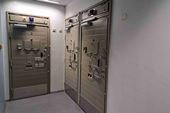New features include detailed virtual mapping for faster incident detection and informed response, a renewed integrated vandalism management solution to help keep the network ‘graffiti free’, among other things, and re-designed controls to assist the team based in the U-Bahn’s Security Operational Control Centre (OCC) in saving valuable time on actions critical to passenger safety.
A real-time view of metro operations – 24/7
Berlin’s U-Bahn comprises over 1,300 vehicles servicing nine lines and connecting 174 stations. The ability to quickly locate any incident reported and understand the situation from the area immediately affected is vital.
Steffen Holz, responsible for the IT infrastructure of BVG’s metro stations, said: “For security reasons, we operate a closed system, so we can’t access ‘open’ web-based tools such as Google Maps. But this level of mapping detail is needed to give situational context to any incident reported to us.”
For this reason, Synectics – a specialist in operational and security management solutions – has developed its own virtual mapping solution for BVG. Schematic interactive station maps combined with a GIS (Geographic Information System) developed using thousands of data sets from the Senate of Berlin, including street names, landmarks, and other key identifiers, provide OCC operators with extremely accurate locational and contextual information to support informed incident response.
This means operators can quickly access details and see the location of stations, cameras and security personnel. In doing so, they can easily switch between different data layers for an accurate real-time view of Berlin metro operations.
Operators can also see the exact location of approximately 550 metro-wide customer emergency pillars. Should one be activated, video and audio from the relevant pillar are immediately streamed to the OCC, with operators easily able to view important location details in the immediate area in order to provide appropriate assistance.
Faster critical support through time-saving operations
The Security OCC team can investigate incident reports and initiate responsive action much quicker, thanks to easier on-screen navigation.
“It might sound relatively minor, but this is of great importance. The way data is displayed on screen significantly affects how fast you can respond to a particular scenario”, explains Mr Holz. “The updated system is much more intuitive, with layouts, colour-coding, icons and many other features, tailored to the way we work. For handling any security incident, the right tool is now only one click away.”
The upgrades complement existing time-saving features. On receiving an incoming emergency alert, an ‘incident’ is automatically created, ensuring that relevant footage and user activity is securely recorded. A log – pre-populated with time, location, metro line and other core information – is also created. Reduced administrative work leaves operators free to focus on handling the event in question. The system also uses workflows – predefined processes that guide users through the next recommended action in line with BVG’s Standard Operating Procedures (SOPs). Workflow technology is also the foundation of ‘virtual security guard’ capabilities, allowing OCC operators to conduct remote security patrols around unmanned stations for improved passenger safety.
Collaboration tools to improve passenger safety
The upgrade project means the Security OCC team can coordinate its activities more effectively with the six BVG’s station management control centres and the police.
Each station management team can access live camera streams and has localised system management and recording, while integrated communications mean that any (emergency) calls received by station management can be transferred to the Security OCC at the touch of a button.
A police officer is permanently located in the control centre and has their own dedicated workstation with access to incident management functions. Operators can work collaboratively with the officer when necessary – sharing tasks and jointly analysing live and recorded footage as required.
Tackling transport network vandalism through surveillance
A dedicated vandalism management module (Vandata) has also been updated to support end-to-end handling of any vandalism scenario, from receiving and processing the initial damage report to assigning and dispatching clean-up teams.
Vandata is a prime example of the high level of modularity achieved in the system. A change which will give BVG much greater flexibility in using and adapting the system in the future.
Mr Holtz added: “The modularisation of our system has been a very important process, as it allows us to add or change applications and functionality far more easily. We now have a system architecture much more suited to evolving with us. There is still work to do on this, but the steps we’ve taken to achieve this flexibility are significant.”
BVG will continue to work with Synectics in maintenance and operation of the system to ensure safety and security objectives are met in line with evolving needs. Video analytics to support threat detection is an area of interest for future development.
















